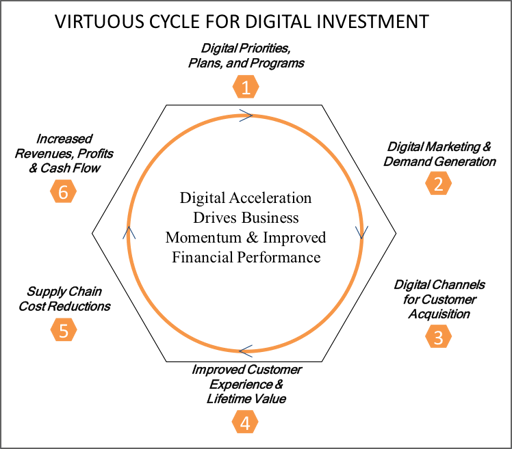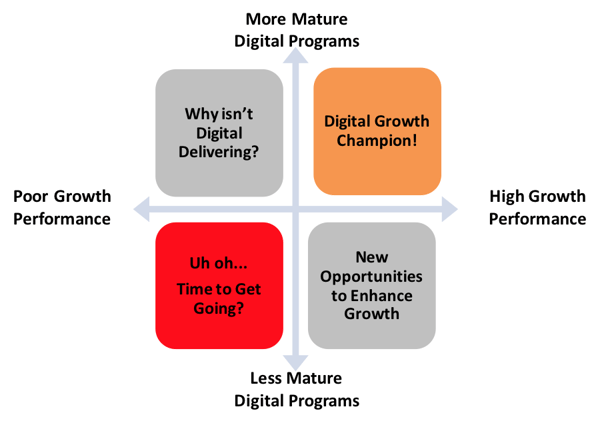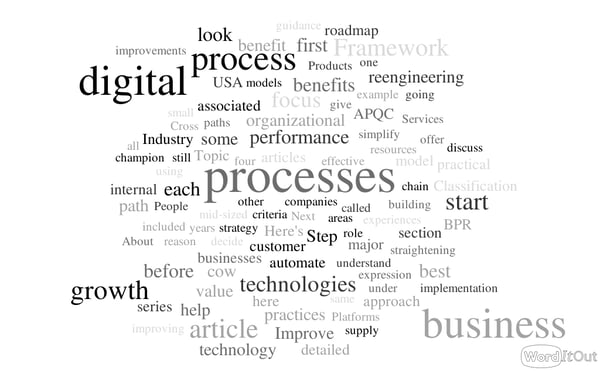CEO Blog - Advice for CEOs on growth and scaling
How Small- and Mid-sized Business (SMBs) Can Execute the “Virtuous Cycle” of Digital Growth

This is the final installment in our series. This article will emphasize effective adoption of best practices, offer a logical sequence to implementation, and discuss building organizational and program maturity. This article will help you understand how to achieve “digital growth champion” status.
This is also the last in a series of five articles focused on helping executives in small- and mid-sized businesses utilize digital technologies effectively to assist in accelerating revenues and profits. If you missed the first four articles, you can find them here:
Building Value by Compounding Best Practices
If you have followed the guidance provided in this series of best practices, then it is fair to ask what additional benefits you can derive from combining the benefits identified. Follow the best practices in people/organization, processes, platforms and technology and you’re on your way to digitally-enabled success.
To understand the compounding effects of benefits, let’s discuss the concepts of a “virtuous cycle” and a “vicious cycle.” These cycles are defined as complex chains of events that reinforce themselves through a feedback loop. A virtuous circle has favorable results, while a vicious circle has detrimental results.
Both circles are complex chains of events with no tendency toward equilibrium—at least in the short run. Both systems of events have feedback loops in which each iteration of the cycle reinforces the previous one. These cycles will continue in the direction of their momentum until an external factor intervenes and breaks the cycle.
You may have come across these models before, but let me adopt them to the digital pathways theme.
Virtuous versus Vicious Cycles of Digital Investment
A version of a virtuous cycle of digital investment can look like this:

Step 1: Digital Priorities, Plans and Programs
Let’s have a guided tour “around the horn.” The appropriate place is with step 1—the development of digital priorities, plans and programs. Good planning creates good results. Good planning can take time, though, and there is always the temptation to “do something.” We call “doing something” without a plan random acts of investment because they are not performed in a consistent context, create a scenario where investments are wasted, and often cause investments to have to be repeated.
Digital priorities and plans are driven by your process priorities. If you want a refresh on how to identify process priorities, you might re-read the second chapter. You do everything at once, and you can’t digitize all your processes at the same time, either.
There is no way we can strongly encourage you enough to spend the time building your digital strategy and plan.
Step 2: Digital Marketing & Demand Generation
For many businesses, we suggest that your immediate priorities should be on digital marketing and demand generation. These two activities start to fill your sales pipeline with a larger number of more qualified prospects. Many will refer to this as “top of funnel” and “middle of funnel” activities. You should be measuring improvements in both the number of new leads, but also in lead quality. Your goal here is to improve your marketing-qualified leads (MQLs) to create more productivity in your customer acquisition programs, and to make it easier for your sales force to convert them into customers.
Digital marketing programs have the potential to generate more leads at lower costs. Good digital programs leverage investments in content. For example, a customer case study can be used as sales collateral, trade show handouts, topics for media and PR, online email programs, online newsletters, resources on your website, and postings on social media like LinkedIn. “Build it once, use it multiple times” is the mantra for content re-use. You can see how benefits are starting to compound even at this early stage in the virtuous cycle.
If you are doing step #2 well, you will see the benefits in step #3.
Step 3: Digital Channels for Customer Acquisition
Your ability to acquire new customers will improve in several ways:
- more highly qualified leads acquired at lower costs
- more efficient use of marketing and sales dollars
- new business derived from targeted digital programs
Digital channels may not be the primary source of new business, but when you look at customer acquisition costs from digital programs compared to leads generated from more traditional channels like direct sales, field sales, and trade shows, we think you’ll like the results. This isn’t an argument to use only digital channels. It is an argument to use them to supplement your other effective lead generation and qualification programs. The compounding effects of the virtuous cycle continue.
Step 4: Improved Customer Experience and Lifetime Value
With more revenue coming in from effective lead generation and conversion programs, the natural benefits of increased customer lifetime value will be realized. This is the primary benefit of step #4. Customer value is the compounding financial benefits from customers acquired cost-effectively and serviced appropriately. In its simplest form, customer lifetime value is the sum of a customer’s contribution to the business minus customer acquisition and ongoing servicing costs. The higher the lifetime value, the more a customer is worth to your business over time.
There is also substantial evidence that seamless digital experiences are rated higher than more traditional customer experiences. There are lots of good examples. Think about your own personal experience with online retailers. You get more information on your order, more timely. You may appreciate recommendations for add-on products or services. You may find online support resources like online training videos are more effective than talking with support resources over the phone. And they are available 24/7.
Here’s one example of improved customer experience from online customer experiences. Years ago, I implemented a self-service Q&A and problem case system. Customers quickly migrated to that option versus talking with our staff. We were able to support twice the number of customers with existing personal backed up by the online service option. And our net promoter scores improved, too.
Now you can start to see the major compounding benefits of more customers, with longer-term relationships who are more loyal and more satisfied.
Step 5: Supply Chain Cost Reductions
As you build increased revenues and profits from the previous steps, you can start to see the additional benefits of scale. Contribution to fixed costs improves. Your buying power increases as your volume increases and you can get more favorable costs from suppliers. You have more leverage with suppliers in negotiating more favorable service levels.
Even without digitizing your supply chain processes, the previous steps are already creating the potential for improved time, value, and reduced costs. More benefits are accumulating.
Step 6: Increased Revenue, Profits, and Cash Flow
You may want to stop here and harvest the benefits which you have been accruing from your digital investments. In that light, the virtuous cycle would stop here. That may be an option, but it may not be the best option.
Financial benefits can be reinvested in your business. Now you can revise your digital priorities, take on more process digitization, spend more on marketing and sales, and start to see the compounding value possible in a virtuous digital model.
Remember the definitions we started with? These cycles are defined as complex chains of events that reinforce themselves through a feedback loop. A virtuous circle has favorable results, while a vicious circle has detrimental results.
We haven’t talked much about vicious cycles, but they are easy to understand. Start with Step 6 and work your way counterclockwise around the model. Lower profitability means less to invest in digitization, which means less effective and less efficient customer acquisition and customer development programs. Fewer customers with shorter relationships reduce both revenues and profits. Reduced customer satisfaction and reduced customer loyalty are part of a process of progressive collapse.
How Does Your Organization Look When You Have the Virtuous Cycle Operating on Your Behalf?
You’ll recall the digital goal we presented earlier.

Now you can realize all the benefits of a Digital Growth Champion:
- Accelerated revenues
- Increased profits
- More customers acquired more cost-effectively
- Increased customer satisfaction and loyalty
- Benefits of increased operational scale
- Benefits of an improved financial results

An Opportunity to Engage
Do you have ideas to share? Are there topics you would like me to specifically address? Shoot me an email and I’ll be happy to chat with you.

Topics: Digital Marketing Tactics, Business Growth Strategy, Digital Marketing, Marketing Technology
Thu, Dec 13, 2018Related Articles

- Press Releases
- Careers
- Case Studies
- Marketing Consultant Company
- Marketing Strategy Consultants
- Marketing Plan Consultants
- B2B Marketing Consultants
- Virtual CMO
- Marketing Consultant Outsourcing
- Fractional CMO
- What is a Fractional CMO
- Healthcare Marketing Consultant
- Marketing Consultant Houston TX Texas
- Marketing Consultant Texas TX
- Marketing Consultant Bay Area
- CEO Blog
- Ebooks Plus
- Executive Marketing Consultants
- Product Marketing Consultants
- B2C Marketing Consultants
- Virtual Marketing Consultants
- Senior Marketing Consultants
- Temporary CMO
- Hire a CMO
- Fractional CMO Salary
- Fractional CMO Responsibilities
- Marketing Consultant Austin TX Texas
- Marketing Consultant Dallas TX Texas
- Marketing Consultant San Antonio
- Helping Private Equity
- Private Equity Blog
- Leadership Team
- Privacy Policy
- Business Marketing Consultants
- Strategic Marketing Consultants
- Marketing Technology Consultants
- Sales and Marketing Consultants
- CMO Job Description
- CMO Salary
- Fractional CMO Agency
- Fractional CMO Services
- CPG Marketing Consultant
- Marketing Consultant San Diego
- Partners
Houston, TX 77056
© 2023 Chief Outsiders


